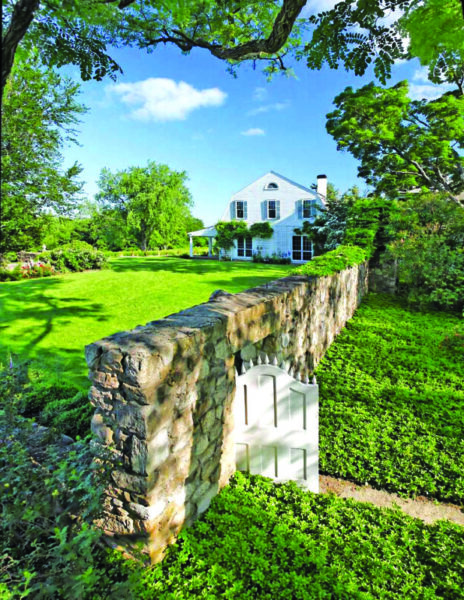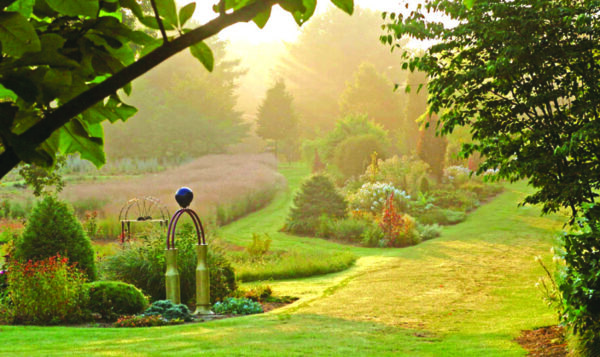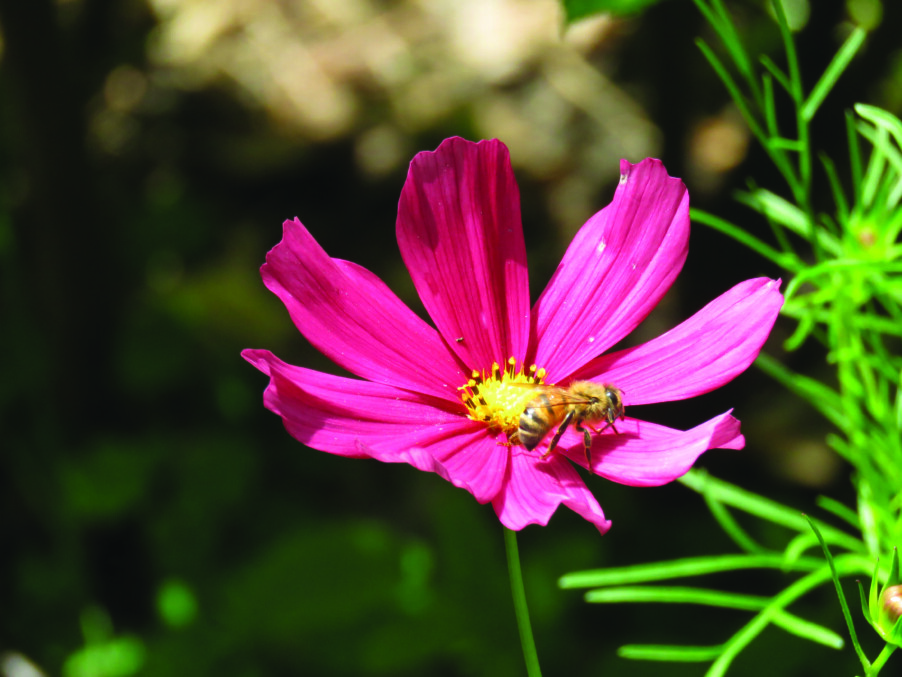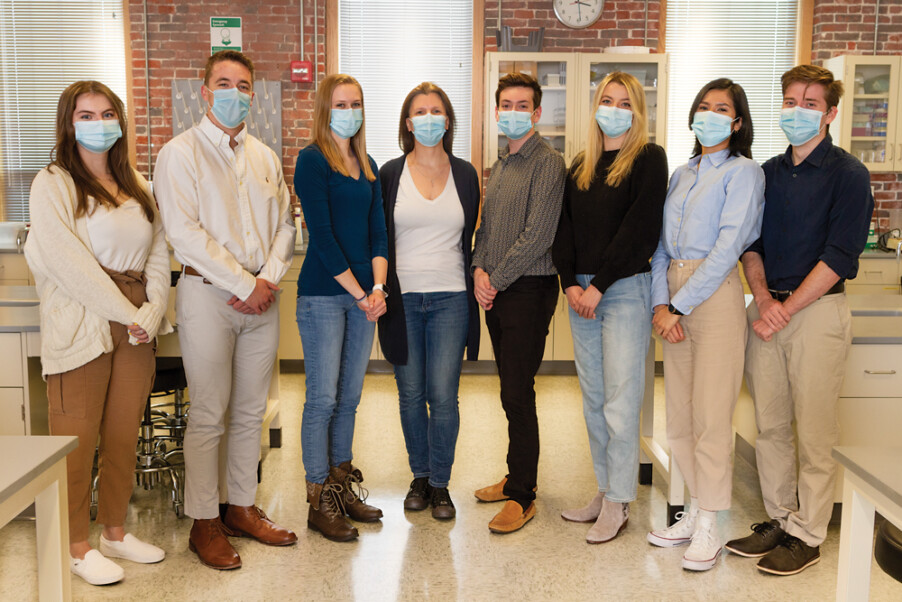Get all of the flower-filled beauty with none of the work at public gardens
Plenty of people like working in the garden, planting and pruning and watching things grow. But there’s something to be said about relaxing in a luxurious garden where you don’t have to lift a finger to reap its rewards. Public gardens are the perfect opportunity to enjoy stunning displays of nature, from flowers that are bursting with color to vibrant trees, grasses and water features. So take a break from weeding — or from endlessly watching HGTV in the hopes that you’ll be inspired to do some weeding — and check out some of these public gardens.
Fuller Gardens
10 Willow Ave., North Hampton 964-5414, fullergardens.org
Colorful history: Fuller Gardens is a public, nonprofit botanical garden that dates back to 1927, when Massachusetts Gov. Alvan Fuller commissioned a landscape architect for his summer estate, known as Runnymede-by-the-Sea. In the ’30s, Fuller — also a successful businessman who started the first auto dealership in Boston — hired another firm to improve those gardens and to create a rose garden to honor his wife, Viola. Since then, the garden has expanded even more, with additions like a Japanese garden and a dahlia display garden.
The brains behind the beauty: Jamie Colen has been the garden director at Fuller since 1999, and there’s a staff of seven that works at the gardens seven days a week.
Standout features: Three acres of gardens featuring annuals and perennials, water features, a koi pond, ornamental statuary and more. Fuller is best known for its roses, Colen said, with about 1,700 rose bushes and approximately 125 varieties.
Growing season: At Fuller Gardens, getting the space ready for its busiest time of year starts in February and March, with work in the greenhouse. There are thousands of pots that have to be replanted, and then the crew gets outside to start the maintenance, like making sure the underground irrigation system is working and undoing all of the winterization that they did back in December, like tying the rose bushes and preserving the statuary and other parts of the garden’s hardscape.
“We basically take care of an outdoor museum,” Colen said.
And yes, there’s raking and pruning and weeding, too. What you won’t see, though, is the crew using bark mulch, a staple gardening supply for many home gardeners.
“Bark mulch is really acidic and you’re putting it on plants that like a neutral pH,” Colen said.
Fuller Gardens is also “virtually pesticide-free,” using potassium bicarbonate to keep the roses pest-free. Colen said they make a point of working with nature, not against it.
“We mow three times a week, no chemicals — there’s no magic here,” he said. “We have some clover. It looks great [and] takes a lot of abuse.”
Your garden experience: Because they do succession planting, there’s never a bad time to see the gardens, Colen said.
“It’s a beautiful design because there’s something in bloom all the time,” he said.
The roses start blooming at the end of June and are often still blooming until November, growing as high as 12 feet tall, Colen said.
“The first bloom is probably the biggest, but it’s not the most spectacular,” he said.
Whenever you choose to go, you can walk through the gardens at your leisure.
The details: Fuller Gardens opened for the season on May 10 and will remain open through mid-October, seven days a week, 10 a.m. to 5:30 p.m. The cost of admission is $9 for adults, $8 for seniors, $6 for students with an ID, $4 for kids under 12 and no charge for infants who are carried.

The Fells
456 Route 103A, Newbury 763-4789, thefells.org
Colorful history: The Fells, which encompasses 83 acres of woodlands and grounds and nearly half a mile of undeveloped Lake Sunapee shoreline, is located in Newbury and is the former summer home of American writer and diplomat John M. Hay (1838-1905), who began acquiring abandoned sheep farms in the late 1800s and ultimately owned nearly 1,000 acres of land. His son Clarence inherited the property when John Hay died in 1905, and he and his wife Alice transformed the rock pasture into extensive formal and informal gardens. In 1960 the Hays deeded 675 acres to the Society for the Protection of New Hampshire Forests to protect it from development, and the remainder was deeded to the U.S. Fish and Wildlife Service in the ’70s.
The brains behind the beauty: HorticulturistNick Scheu has been the landscape director at The Fells for three seasons and has an assistant and typically two interns in the landscape department.
Standout features: There are eight major gardens at The Fells, which is listed on the National Register of Historic Places. Scheu said The Fells is well known for its rhododendrons, and he particularly likes the heath and the heather, and the “lovely” perennial border that dates back to 1909. There’s also a poetry walk and an ecology trail. On the property this year will be the Art in Nature 2021 Sculpture Exhibit, with pieces that areintegrated into the surrounding landscape and are based on the theme “Stillness & Motion.”
Growing season: Getting the property ready for the spring season starts in mid-March, Scheu said, when they start uncovering winterized plants and pruning the fruit trees and shrubs. Scheu runs pruning workshops throughout the spring, specific to blueberries, apple trees, spring bloomers and more, plus potting workshops that have participants potting seed and planting plugs for both The Fells and their own home gardens.
Your garden experience: Though the landscape will evolve throughout the spring and summer, “We hope we have things in flower pretty much from May to September or November,” Scheu said. Different plants do shine at different times, though, he said, noting that the rhododendron and azaleas are especially nice from mid-May to mid- to late July, while the asters in the fall are on full display and attract hundreds of butterflies.
“Early summer gardens are always a joy to see,” Scheu said. “[They have] really great colors and new growth appearing from Memorial Day to the end of June.”
The Fells offers guided garden tours each day that the Main House is open (see details below), and there’s a free guided hike on the first Thursday of every month. At any time, you can “casually walk the grounds and enjoy whatever is flowering,” Scheu said.
He said there’s often wildlife to see too — he had just left a fox den full of babies, and it’s not unusual to have deer, bear and fisher cats roaming the property.
Scheu suggests that prior to visiting The Fells guests should look at the extensive website, which includes maps of the property, a calendar of events and other useful information that can enhance the experience.
The details: The gardens and trails at The Fells are open daily year-round, and visitors may hike the trails and visit the gardens from dawn until dusk. The Fells’ Main House opens for the season on Saturday, May 29, and will be open on weekends until the summer season begins on June 16, at which point it will be open Wednesdays through Sundays until Sept. 6, when it reverts back to weekends and Monday holidays only, through Columbus Day. The hours are 10 a.m. to 4 p.m. each day. When the Main House is open, the cost of admission is $10 for adults, $8 for seniors and students, $4 for kids 6 to 17, free for kids 5 and under, and $25 for families of two adults and two or more children ages 6 or above. When the Main House is closed, admission is $8 for adults, $6 for seniors and students, $3 for children and $15 for families of two adults and two or more children ages 6 or above. Winter admission, December through March, is $5 per household, payable at the self-serve Welcome Kiosk. Admission is always free for active military members and veterans, and their immediate family.
Forty-minute guided tours of the gardens, included in the cost of admission, are offered Wednesday through Sunday, Memorial Day weekend through Columbus Day weekend. Tours begin in Rose Garden at 11 a.m.
Scheu will host the next potting workshop on Saturday, May 22, from 9 to 11:30 a.m. The $5 per person fee includes a sample of plant specimens to take home. Reservations are required; call 763-4789, ext. 3. Check the website’s list of events for all kinds of activities scheduled throughout the remainder of the year.

Bedrock Gardens
45 High Road, Lee 828-8300, bedrockgardens.org
Colorful history: The original farmhouse at Bedrock Gardens dates back to the 18th century, and the property was a dairy farm from 1845 to 1957. It was sold to the present owner in 1980 on a handshake, the 37 acres having been abandoned for about 40 years. It was first cleared of poison ivy and puckerbrush, and the landscaping project started around 1987, adding access to roads along with garden beds and a wildlife pond. About two-thirds of the property is now gardens.
The brains behind the beauty: Led by Executive DirectorJohn Forti, Bedrock Gardens also has a group of volunteers and a small ground crew. The founders are still very involved: “The two of them are like having a staff of a dozen,” Forti said.
Standout features: One main focus at Bedrock Gardens is showcasing rare and unusual native plants. “Everything looks vaguely familiar, but [for example], you’ve never seen a maple quite like that,” Forti said. There’s the ornamental Grass Acre — “the space was designed to look like an impressionist painting,” Forti said. “It evolves through the whole season.” There’s also a spiral garden, a rock garden, a Japanese Tea House and garden, and a serpentine waterway that Forti particularly likes, with its lotus and water lilies and the sense of motion that it adds to the landscape.
Growing season: “We are a garden that looks at sustainability,” Forti said. “We’re not racing to put out tens of thousands of annuals in the spring. … We really rely on perennials.
Of course there are a few garden cleanup days, plus planting the annuals and improving soil quality, he said, but the garden is laid out on a sort of grid system so that everything is easy to get to and maintain.
Your garden experience: “Unlike a lot of other public gardens, it’s not a single design space — it’s a landscape journey,” Forti said. “Over the course of 37 acres it keeps you moving through room after room, and each space has its own feeling and emotion.”
Forti said there are a number of ways to enjoy the garden, whether you want to take a walk along the mile-plus of walking trails, get a guided tour to learn about the gardens, or just relax. Forti said that one volunteer has said that when she walks through the gardens her blood pressure goes down about 20 points.
“Some people are just going there to quiet their minds … [and] enjoy nature,” he said. “They love to relax into the landscape. … You might be relaxing and reflecting by a pond and then move on … to a different garden.”
He said you can spend a couple hours there or a whole day — and there’s no “best” time of the year to visit.
“It’s so different by the season, and that’s … part of its design,” he said.
The details: Bedrock Gardens opened for the season on May 12 and is open Tuesday through Friday, and the first and third weekends of the month, through Oct. 11. The hours each day are 10 a.m. to 4 p.m. There’s a suggested donation of $10 per adult; children 12 and under get in free. Daily overview garden tours are offered Tuesday through Friday at 10:15 a.m. and Saturday and Sunday at 10:15 a.m. and 1 p.m., when open. The guided tours are free with admission. You can also take a self-guided tour and spend as much time as you want on the property; you will be given a map with a suggested route.

Kirkwood Gardens
Squam Lakes Natural Science Center, 23 Science Center Road, Holderness, 968-7194, nhnature.org
Colorful history: Kirkwood Gardens is about an acre in size and was created on the grounds of the historic Holderness Inn, in the space of a former parking lot. In trying to figure out what should take the place of the parking lot, a plan put together by internationally known landscape designer — and six-year Science Center trustee — “Sunny” Grace Kirkwood won out. It used plants that are adapted to grow well in New Hampshire and that are attractive to birds, bees and other pollinators, according to resident garden expert Brenda Erler. Erler said Kirkwood was very elderly when she was designing the garden. “Her nurse would actually bring her to the gardens, complete with her oxygen tank, and she would just sit for hours and watch the shadows to see how [the sun would hit the plants],” Erler said. The entire community pitched in to make the design happen, from an anonymous gift to amend the soil to area garden centers and local residents donating plants, garden features and labor. Kirkwood only survived long enough to see the upper garden planted, Erler said; that was completed in August 1996, and Kirkwood died in September. “It was the last garden that she ever donated in the United States,” Erler said.
The brains behind the beauty: According to Marketing Manager Amanda Gillen, Brenda Erler is the “expert on all things Kirkwood Gardens.” Erler has been at the Science Center since before the gardens were designed, and she leads a group of volunteers in maintaining the gardens.
Standout features: A 25- by 60-foot bluestone patio offers scenic views and a place to sit in the summer shade. The upper garden has a variety of ferns, hostas, azaleas, rhododendrons and other shade-loving plants, while the lower garden features sun-loving shrubs, trees and perennials, a sundial and a millstone fountain that attracts birds and butterflies.
Growing season: Erler said that each season she and a group of volunteers do the pruning and cleanup of winter debris as well as improvements and enhancements. “We keep kind of adding things to the fringes and [consider the] things we want to improve the looks of, [like] the exits, the entrances.” She said at the start of the season the volunteers do a walkaround to see how the plants are doing and whether any need to be replaced or moved, and they figure out which annuals to plant.
Your garden experience: “People will see plants that will work well in their yard,” Erler said, noting that the plants have been labeled and a kiosk has information for every plant, including their growing conditions, to help anyone who might want to bring something home for their own garden. “You can spend time learning about the plants or just sitting on one of the benches and enjoying it,” Erler said. “People use the garden in all different ways.” There’s also a list of birds and butterflies to help people ID them.
Erler said that while the bulbs are “going like mad right now,” the gardens always have something to offer.
“Sunny was just a master at designing things, and there’s always something in bloom,” she said. “It changes radically through the seasons.”
One of Erler’s favorites is Joe Pye weed, a native plant that grows in wetlands.
“Most of the year people just ignore it, but when it goes into bloom the butterflies absolutely lose their minds over it,” she said. “There are so many monarchs hanging on it.”
Details: Kirkwood Gardens is open to the public daily, and there is no cost to get in and no need for reservations. However, if you want to spend a day at the Squam Lakes Science Center, admission is $18 for adults and seniors and $13 for ages 3 to 15, and it includes the live animal exhibit trail and all hiking trails. Trail passes must be pre-purchased online before arriving at the Science Center. The live animal exhibit trail and hiking trails are open daily from 9:30 a.m. to 5 p.m. (last trail admission is 3:30 p.m.).
More public gardens
Here are a few other public gardens to check out. If you know of any more beautiful public spaces like these, let us know at news@hippopress.com.
Maple Hill Gardens
Beaver Brook Association, 117 Ridge Road, 465-7787, beaverbrook.org
The 13 theme gardens, wildflower trail and natural play area are open to the public daily. The gardens are maintained by volunteers, and garden tours and presentations are available.
Prescott Park
Marcy Street, Portsmouth, 610-7208, cityofportsmouth.com/prescottpark
The gardens at Prescott Park are free and open to the public. In 1975, 40 formal garden beds were created on the South Lawn of Prescott Park, designed to study which varieties of ornamental plants performed best in the seacoast environment. Now, the gardens continue to be planted and maintained by the city’s Parks & Greenery department, which IDs the plants and flowers for visitors.
Tarbin Gardens
321 Salisbury Road, Franklin, 934-3518, tarbingardens.com
Opening in June, Tarbin Gardens is a hand-built English landscape garden covering five acres, with all kinds of plants, plus greenhouses, ponds and wildlife. The cost of admission (cash only) is $10 for adults, $8 for seniors and students, and $30 for families of two parents and two or more children. Hours are Wednesday through Sunday from 10 a.m. to 6 p.m.
Featured photo: Pollinator on Cosmos. Photo courtesy of Squam Lakes Natural Science Center.





